Reduction of Dust on Solar Panels through Unipolar Electrostatic Traveling Wave
Abstract
:1. Introduction
- Electrical power requirements and dust accumulation rates
- Frequency of the operation of the screens
- Efficiency of EDS and Dust Removal Efficiency
- Placement of EDS system on the solar panels to reduce power loss in PV panel and increase optical transmission efficiency.
2. Controller Card for Electrostatic Cleaning System
3. Electrode Design
4. Experimental Studies and Evaluation
4.1. Electrostatic Cleaning
4.2. Cost Comparison
5. Conclusions
Author Contributions
Funding
Institutional Review Board Statement
Informed Consent Statement
Data Availability Statement
Acknowledgments
Conflicts of Interest
References
- Kazem, A.A.; Chaichan, M.T.; Kazem, H.A. Dust effect on photovoltaic utilization in Iraq. Renew. Sustain. Energy Rev. 2017, 37, 734–749. [Google Scholar] [CrossRef]
- Aly, S.P.; Gandhidasan, P.; Barth, N.; Ahzi, S. Novel dry cleaning machine for photovoltaic and solar panels. In Proceedings of the 3rd International Renewable and Sustainable Energy Conference (IRSEC), Marrakech, Morocco, 10–13 December 2015; pp. 1–6. [Google Scholar] [CrossRef]
- Ghazi, S.; Sayigh, A.; Ip, K. Dust effect on flat surfaces—A review paper. Renew. Sustain. Energy Rev. 2014, 33, 742–751. [Google Scholar] [CrossRef]
- Abbas, K.K.; Al-Wattar, A.J.; Kasim, N.K. New technique for treatment of the dust accumulation from pv solar panels surface. Iraqi J. Phys. 2010, 8, 54–59. [Google Scholar]
- Darwish, Z.A.; Kazem, H.A.; Sopain, K.; Alghoul, M.A.; Chaichan, M.T. Impact of some environmental variables with dust on solar photovoltaic(pv) performance: Review and research status. Int. J. Energy Environ. 2013, 7, 152–159. [Google Scholar]
- Altıntaş, M.; Arslan, S. Analysis of Atmospheric Transported Particulate Matter and Investigation of Its Effects on Solar Panel. In Proceedings of the 9th European Conference on Renewable Energy Systems, Istanbul, Turkey, 21–23 April 2021; pp. 712–718. [Google Scholar]
- Casanova, J.Z.; Piliougine, M.; Carretero, J.; Bernaola, P.; Carpena, P.; Mora-Lopez, L.; Sidrach-Cardona, M. Analysis of dust losses in photovoltaic modules. In Proceedings of the World Renewable Energy Congress, Malaga, Spain, 8–13 May 2011. [Google Scholar] [CrossRef] [Green Version]
- Mazumder, M.K.; Sharma, R.; Biris, A.S.; Zhang, J.; Calle, C.; Zahn, M. Self-cleaning transparent dust shields for protecting solar panels and other devices. Part. Sci. Technol. 2007, 25, 5–20. [Google Scholar] [CrossRef]
- Sulaiman, S.A.; Singh, A.K.; Mokhtar, M.M.M.; Bou-Rabee, M.A. Influence of Dirt Accumulation on Performance of PV Panels. Energy Procedia 2014, 50, 50–56. [Google Scholar] [CrossRef] [Green Version]
- Al Shehri, A.; Parrott, B.; Carrasco, P.; Al Saiari, H.; Taie, I. Impact of dust deposition and brush-based dry cleaning on glass transmittance for pv modules applications. Sol. Energy 2016, 135, 317–324. [Google Scholar] [CrossRef]
- Mazumder, M.; Horenstein, M.N.; Stark, J.W.; Girouard, P.; Sumner, R.; Henderson, B.; Sharma, R. Characterization of electrodynamic screen performance for dust removal from solar panels and solar hydrogen generators. IEEE Trans. Ind. Appl. 2013, 49, 1793–1800. [Google Scholar] [CrossRef]
- Maghami, M.R.; Hizam, H.; Gomes, C.; Radzi, M.A.; Rezadad, M.I.; Hajighorbani, S. Power loss due to soiling on solar panel: A review. Renew. Sustain. Energy Rev. 2016, 59, 1307–1316. [Google Scholar] [CrossRef] [Green Version]
- Chanchangi, Y.N.; Ghosh, A.; Sundaram, S.; Mallick, T.K. Dust and PV performance in Nigeria: A review. Renew. Sustain. Energy Rev. 2020, 21, 1–14. [Google Scholar] [CrossRef]
- Chen, E.Y.T.; Ma, L.; Yue, Y.; Guo, B.; Liang, H. Measurement of dust sweeping force for cleaning solar panels. Sol. Energy Mater. Sol. Cells 2018, 179, 247–253. [Google Scholar] [CrossRef]
- Zhao, W.; Lv, Y.; Wei, Z.; Yan, W.; Zhou, Q. Review on dust deposition and cleaning methods for solar PV modules. J. Renew. Sustain. Energy 2021, 13, 032701. [Google Scholar] [CrossRef]
- Hudedmani, M.G.; Joshi, G.; Umayal, R.M.; Revankar, A. A comparative study of dust cleaning methods for the solar PV panels. Adv. J. Grad. Res. 2017, 1, 24–29. [Google Scholar] [CrossRef] [Green Version]
- He, G.; Zhou, C.; Li, Z. Review of self-cleaning method for solar cell array. Procedia Eng. 2011, 16, 640–645. [Google Scholar] [CrossRef] [Green Version]
- Lu, X.; Zhang, Q.; Hu, J. A linear piezoelectric actuator based solar panel cleaning system. Energy 2013, 60, 401–406. [Google Scholar] [CrossRef]
- Vasiljev, P.; Borodinas, S.; Bareikis, R.; Struckas, A. Ultrasonic system for solar panel cleaning. Sens. Actuators A Phys. 2013, 200, 74–78. [Google Scholar] [CrossRef]
- Masuda, S.; Washizu, M.; Iwadare, M. Separation of small particles suspended in liquid by nonuniform traveling field. IEEE Trans. Ind. Appl. 1987, 23, 474. [Google Scholar] [CrossRef]
- Kawamoto, H.; Shibata, T. Electrostatic cleaning system for removal of sand from solar panels. J. Electrost. 2015, 73, 65–70. [Google Scholar] [CrossRef]
- Biris, A.S.; Sanini, D.; Srirama, P.K.; Mazumder, P.K.; Sims, R.A.; Calle, C.I. Electrodynamic removal of contaminant particles and its applications. In Proceedings of the Conference Record 39th IEEE, IAS Annual Meeting, Seattle, WA, USA, 3–7 October 2004; pp. 1283–1286. [Google Scholar] [CrossRef]
- Kawamoto, H.; Guo, B. Improvement of an electrostatic cleaning system for removal of dust from solar panels. J. Electrost. 2018, 91, 28–33. [Google Scholar] [CrossRef]
- Alizadehyazdi, V.; Bonthron, M.; And Spenko, M. Optimizing electrostatic cleaning for dust removal on gecko-inspired adhesives. J. Electrost. 2020, 108, 103499. [Google Scholar] [CrossRef]
- Mazumder, M.K. Self-Cleaning Solar Panels and Concentrators with Transparent Electrodynamic Screens. U.S. Patent No. 9,433,336, 6 September 2016. [Google Scholar]
- Kawamoto, H.; Uchiyama, M.; Cooper, B.L.; McKay, D.S. Mitigation of lunar dust on solar panels and optical elements utilizing electrostatic traveling-wave. J. Electrost. 2011, 69, 370–379. [Google Scholar] [CrossRef]
- Xu, L.; Shi, H.; Wang, L.; Xiao, W.; Li, Q.; Guo, J. The Efficiency Characteristic of Electrostatic Dust Precipitation Using Solar Energy. Therm. Sci. 2020, 24, 2857–2864. [Google Scholar] [CrossRef] [Green Version]
- Chesnutt, J.K.; Ashkanani, H.; Guo, B.; Wu, C.Y. Simulation of microscale particle interactions for optimization of an electrodynamic dust shield to clean desert dust from solar panels. Sol. Energy 2017, 155, 1197–1207. [Google Scholar] [CrossRef]
- Calle, C.I.; Buhler, C.R.; Mantovani, J.G.; Clements, S.; Chen, A.; Mazumder, M.K.; Nowicki, A.W. Electrodynamic shield to remove dust from solar panels on Mars. In Proceedings of the 41th Space Congress, Cape Canaveral, FL, USA, 27–30 April 2004; Volume I, pp. 202–206. [Google Scholar]
- Calle, C.I.; Buhler, C.R.; Mcfall, J.L.; Snyder, S.J. Particle removal by electrostatic and dielectrophoretic forces for dust control during lunar exploration missions. J. Electrost. 2009, 67, 89–92. [Google Scholar] [CrossRef] [Green Version]
- Guangming, W.; Dan, L.; Guangjian, X.; Tianlan, Y. The mechanism study of dust removal with transparent interdigitated electrodes. Integr. Ferroelectr. 2016, 171, 1–7. [Google Scholar] [CrossRef] [Green Version]
- Yilbas, B.S.; Al-Qahtani, H.; Al-Sharafi, A.; Bahattab, S.; Hassan, G.; Al-Aqeeli, N.; Kassas, M. Environmental dust particles repelling from a hydrophobic surface under electrostatic influence. Sci. Rep. 2019, 9, 1–18. [Google Scholar] [CrossRef]
- Jiang, J.; Lu, Y.; Yan, X.; Wang, L. An optimization dust-removing electrode design method aiming at improving dust mitigation efficiency in lunar exploration. Acta Astronaut. 2020, 166, 59–68. [Google Scholar] [CrossRef]
- Kawamoto, H. Improved detachable electrodynamic cleaning system for dust removal from soiled photovoltaic panels. J. Electrost. 2020, 107, 103481. [Google Scholar] [CrossRef]
- Faes, A.; Petri, D.; Champliaud, J.; Jonas Geissbühler, J.; Badel, N.; Levrat, J.; Roustom, B.; Hessler-Wyser, A.; Wyrsch, N.; Ballif, C.; et al. Field test and electrode optimization of electrodynamic cleaning systems for solar panels. Wiley Prog. Photovolt. Prog. Photovolt. Res. Appl. 2019, 27, 1020–1033. [Google Scholar] [CrossRef]
- Kawamoto, H. Sampling of small regolith particles from asteroids utilizing an alternative electrostatic field and electrostatic traveling wave. J. Aerosp. Eng. 2014, 27, 631–635. [Google Scholar] [CrossRef]
- Sharma, R.; Wyatt, C.A.; Zhang, J.; Calle, C.I.; Mardesich, N.; Mazumder, M.K. Experimental evaluation and analysis of electrodynamic screen as dust mitigation technology for future mars missions. IEEE Trans. Ind. Appl. 2009, 45, 591–596. [Google Scholar] [CrossRef]
- Calle, C.I.; Mcfall, J.L.; Buhler, C.R.; Snyder, S.J.; Arens, E.E.; Chen, A.; Trigwell, S. Dust particle removal by electrostatic and dielectrophoretic forces with applications to NASA exploration missions. In Proceedings of the ESA Annual Meeting on Electrostatics, ESA Minneapolis, MN, USA, 17–19 June 2008. [Google Scholar]
- Manyapu, K.K.; De Leon, P.; Peltz, L.; Gaier, J.R.; Waters, D. Proof of concept demonstration of novel technologies for lunar spacesuit dust mitigation. Acta Astronaut. 2017, 137, 472–481. [Google Scholar] [CrossRef]
- Mazumder, M.K.; Horenstein, M.N.; Joglekar, N.R.; Sayyah, A.; Stark, J.W.; Bernard, A.A.; Griffin, A.C. Mitigation of dust impact on solar collectors by water-free cleaning with transparent electrodynamic films: Progress and challenges. IEEE J. Photovolt. 2017, 7, 1342–1353. [Google Scholar] [CrossRef]
- Syafiq, A.; Pandey, A.K.; Adzman, N.N.; Abd Rahim, N. Advances in approaches and methods for self-cleaning of solar photovoltaic panels. Sol. Energy 2018, 162, 597–619. [Google Scholar] [CrossRef]
- Altintaş, M.; Arslan, S. Pvsyst ile Güneş Paneli Kirlik Etkilerinin İncelenmesi: Şanlıurfa Güneş Enerjisi Santrali Örneği, 2nd ed.; Eda Altunel; Gece Kitaplığı: Ankara, Turkey, 2020; pp. 65–84. Available online: https://www.gecekitapligi.com/Webkontrol/uploads/Fck/cilt1_7.pdf (accessed on 28 May 2021).
- Altıntaş, M.; Arslan, S. The Study of Dust Removal Using Electrostatic Cleaning System for Solar Panels. Sustainability 2021, 13, 9454. [Google Scholar] [CrossRef]
- Sayyah, A.; Horenstein, M.N.; Mazumder, M.K.; Ahmadi, G. Electrostatic force distribution on an electrodynamic screen. J. Electrost. 2016, 81, 24–36. [Google Scholar] [CrossRef] [Green Version]
- Jiang, J.; Lu, Y.; Zhao, H.; Wang, L. Experiments on dust removal performance of a novel PLZT driven lunar dust mitigation technique. Acta Astronaut. 2019, 165, 17–24. [Google Scholar] [CrossRef]
- Özkaya, M. Yüksek Gerilim Tekniği, Cilt 1, Cilt 2; Birsen Yayınevi: Istanbul, Turkey, 1996. [Google Scholar]
- Aküzüm, T.; Çakmak, B.; Gökalp, Z. Türkiye’de su kaynakları yönetiminin değerlendirilmesi. Int. J. Agric. Nat. Sci. 2010, 3, 67–74. [Google Scholar]
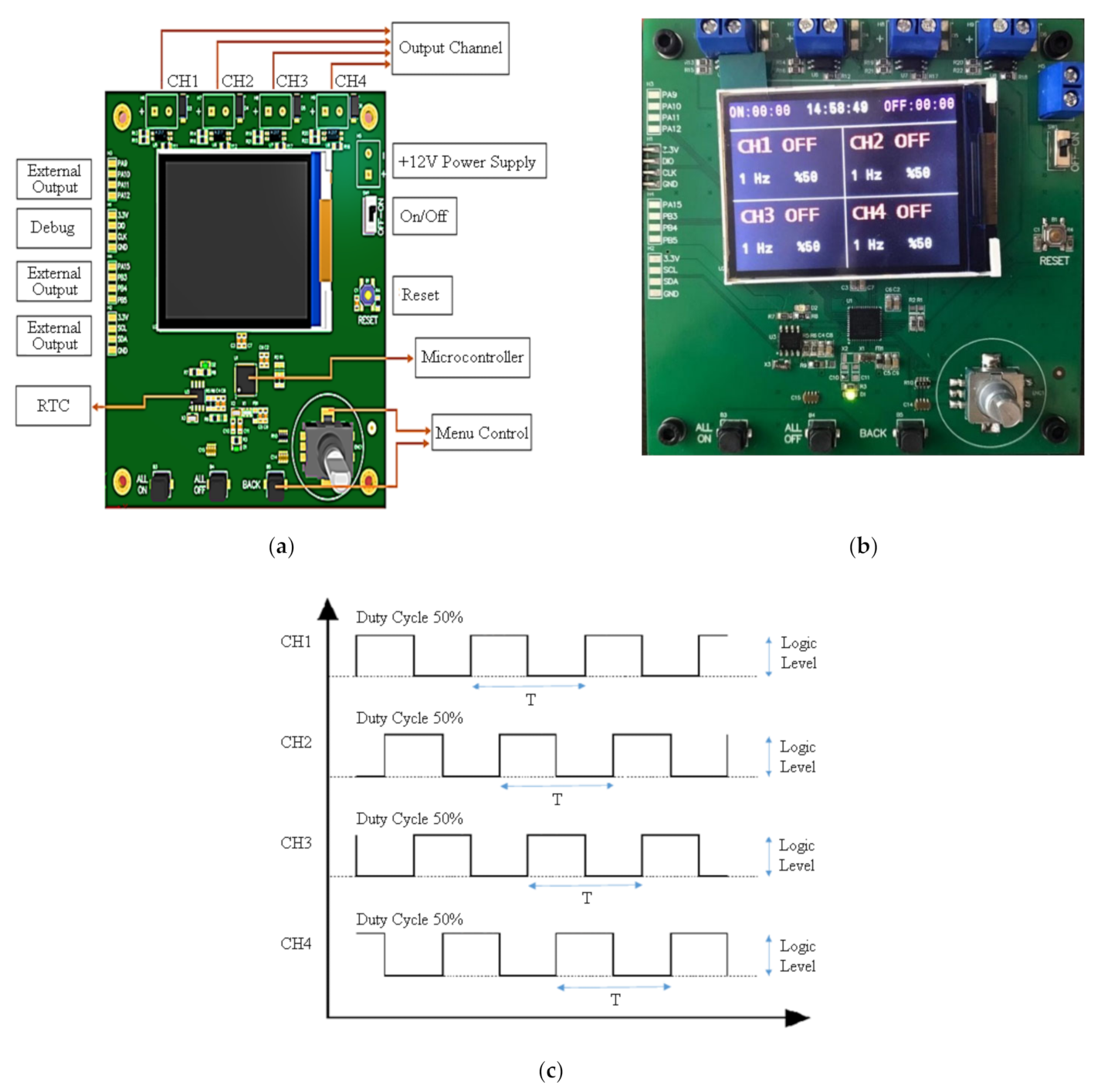
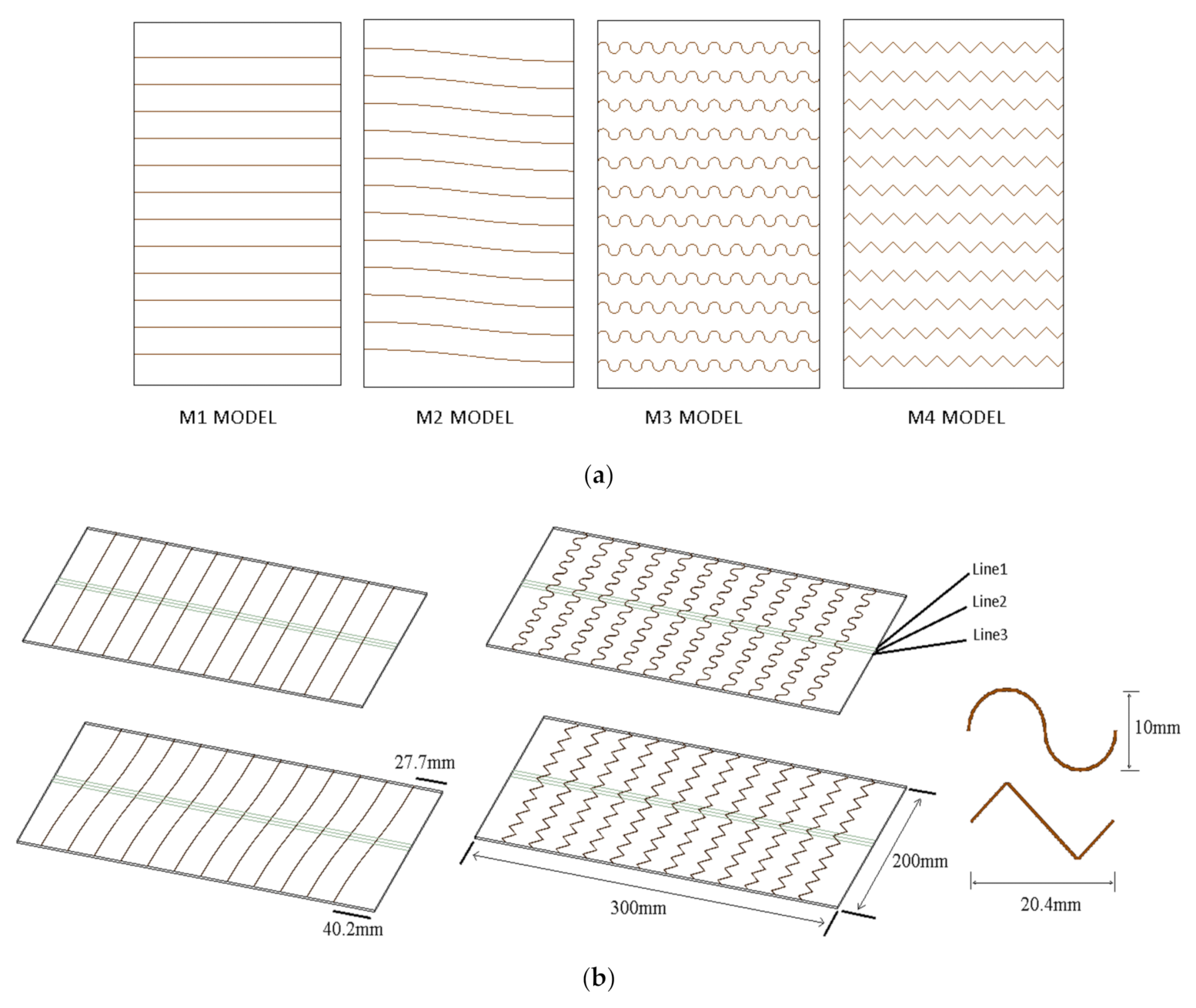

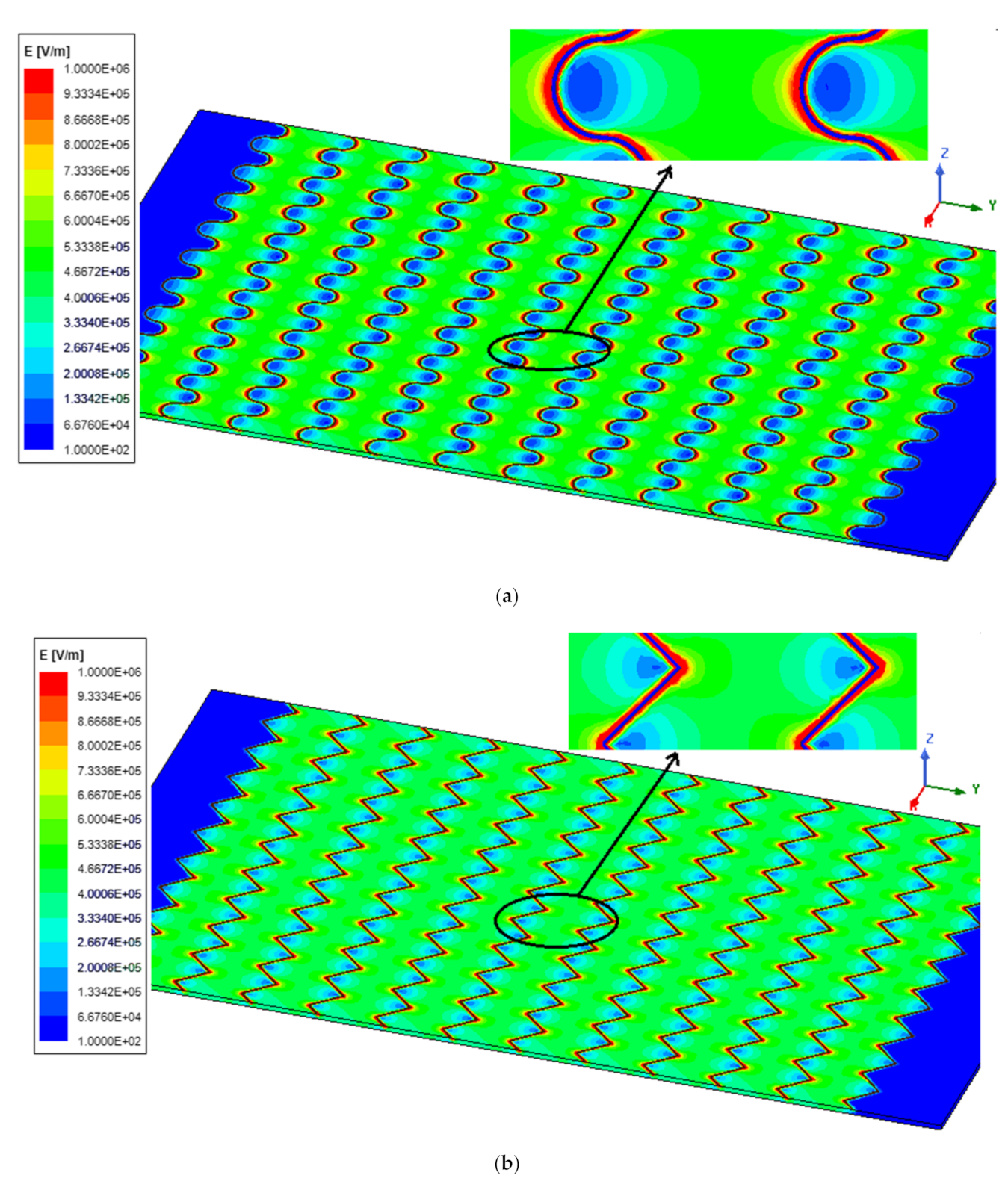

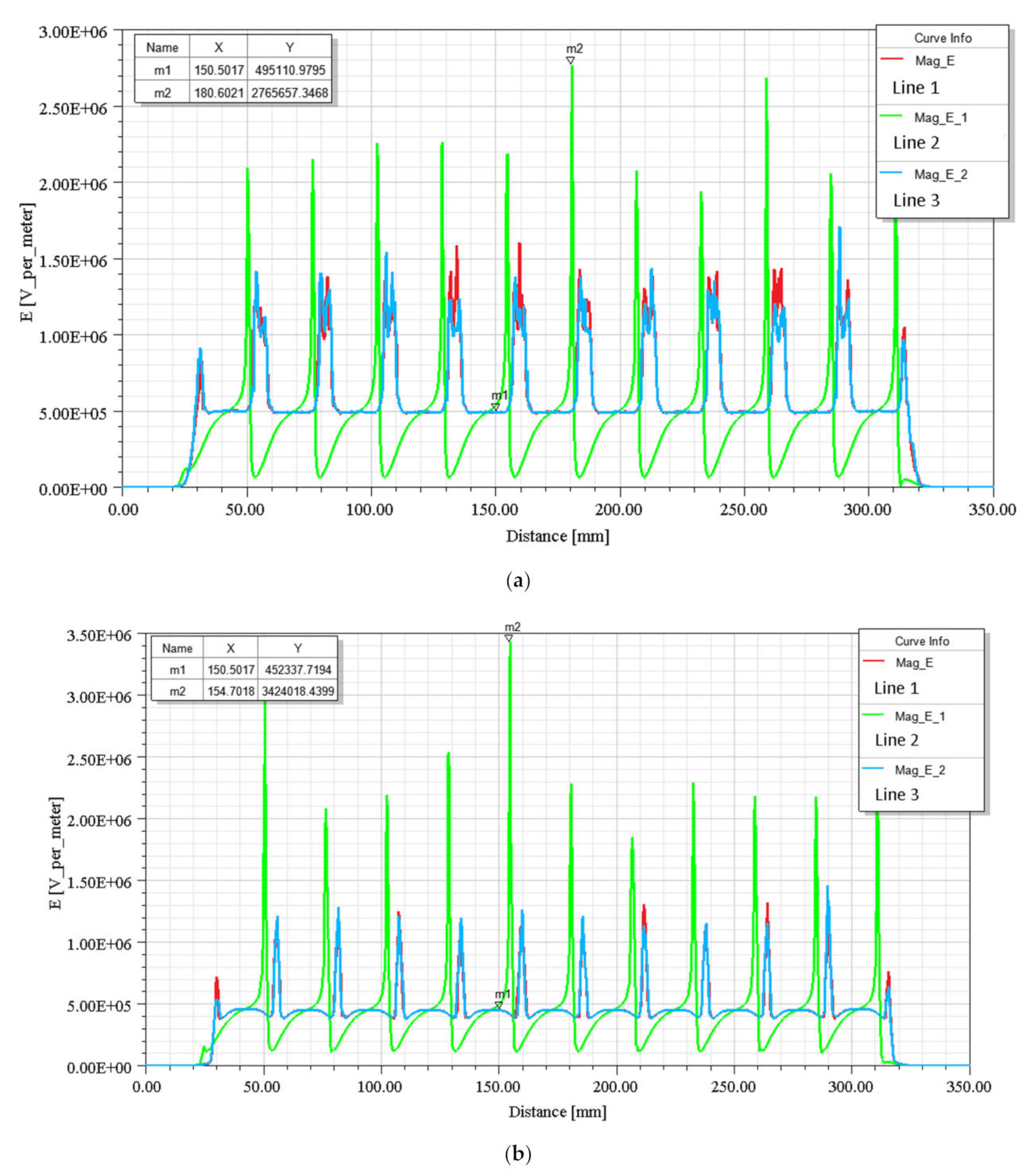
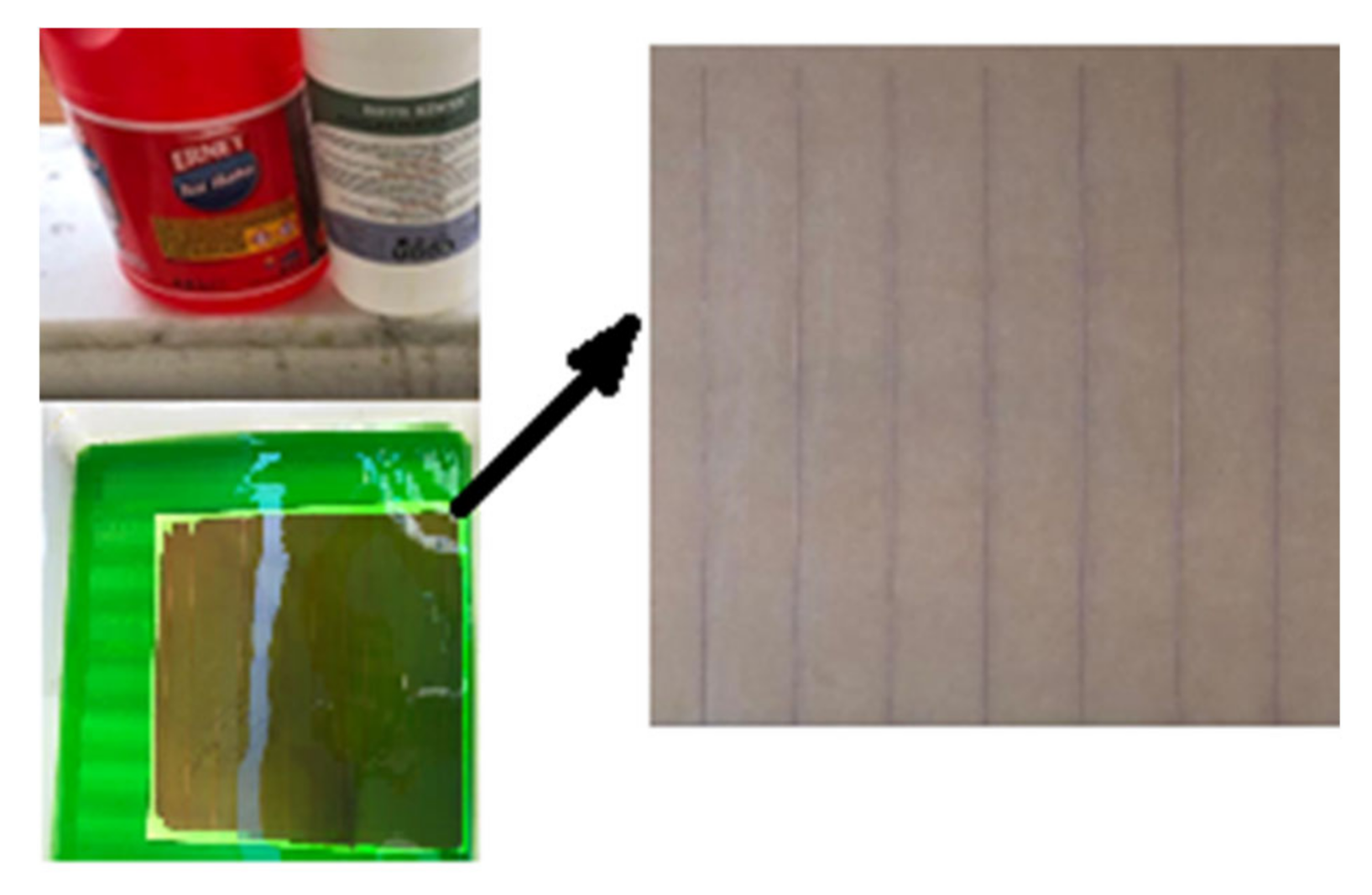
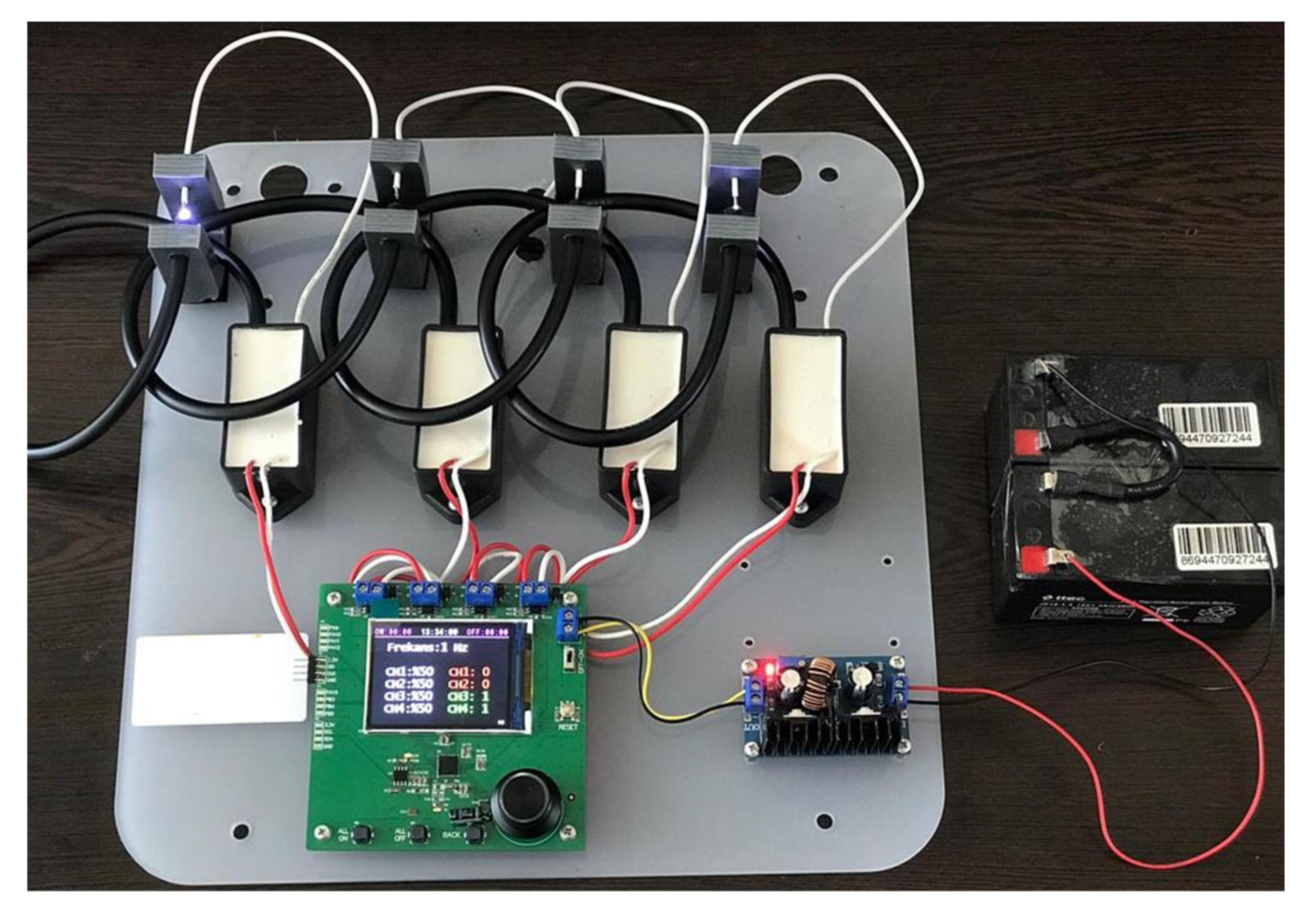
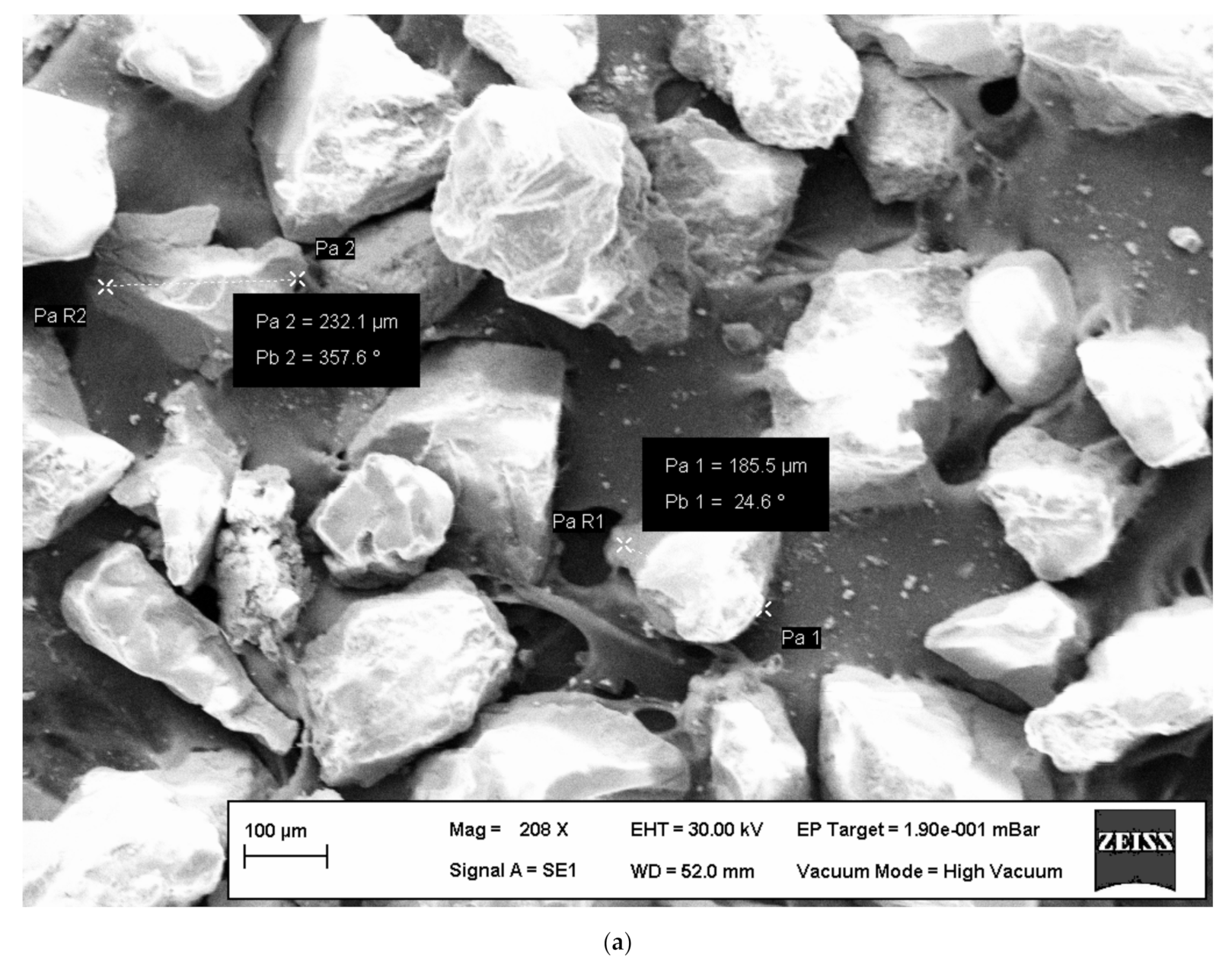
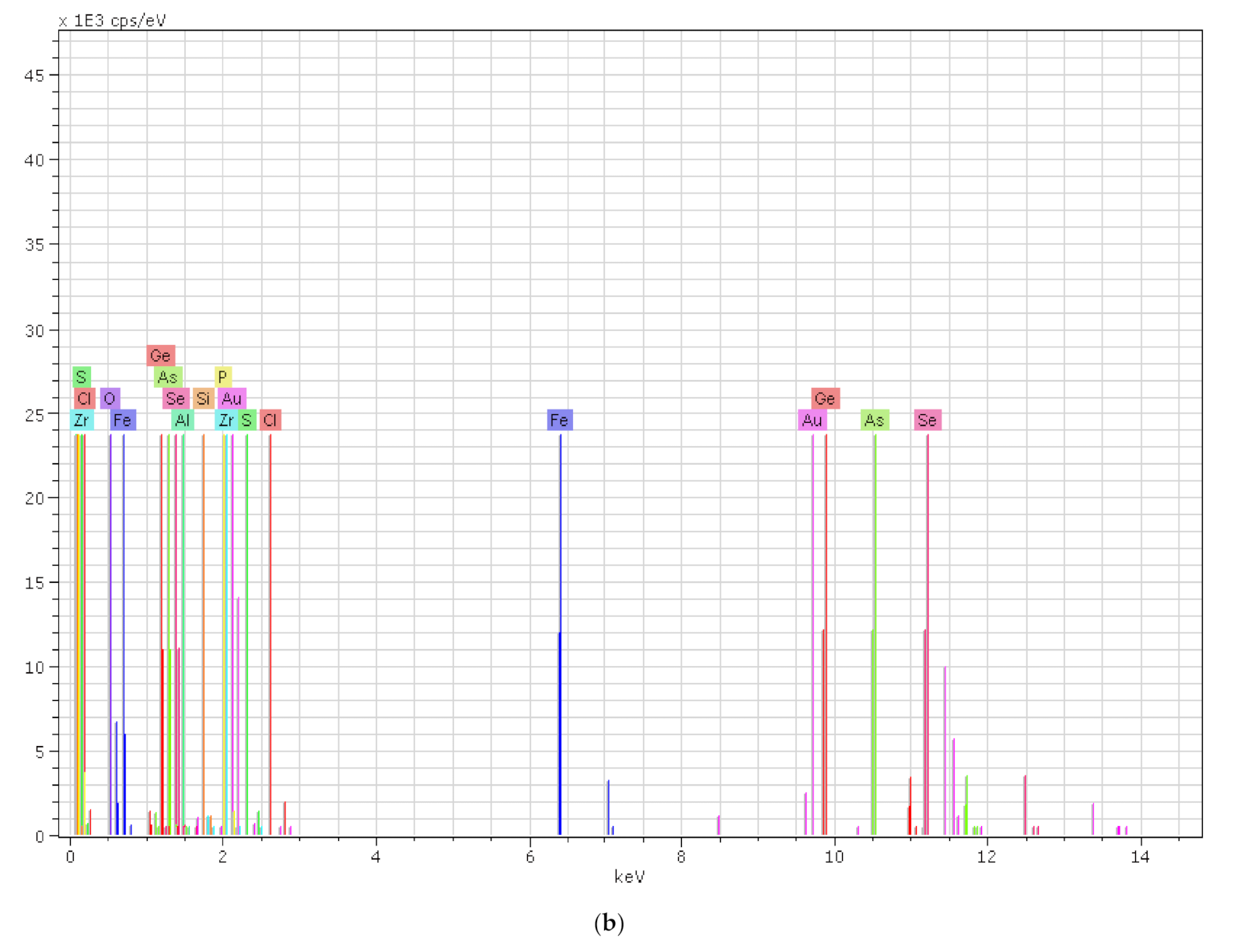


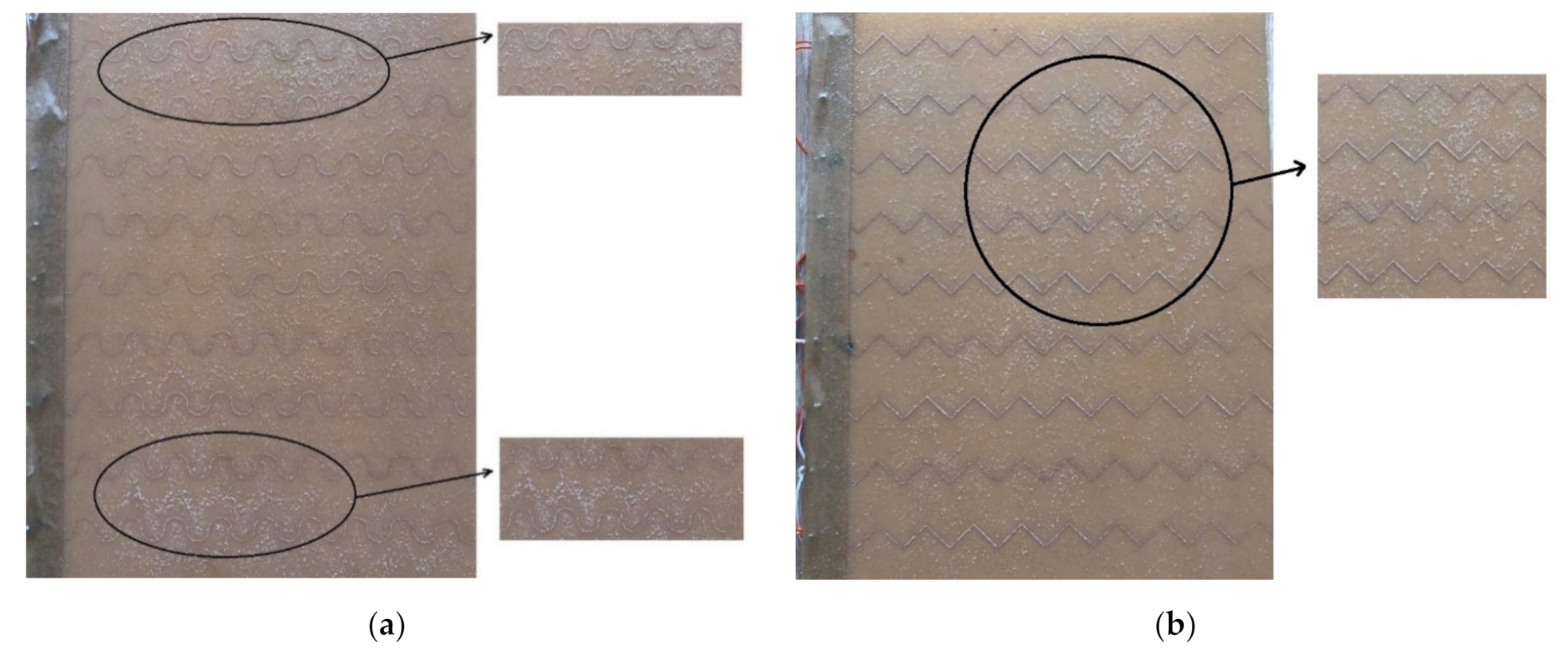
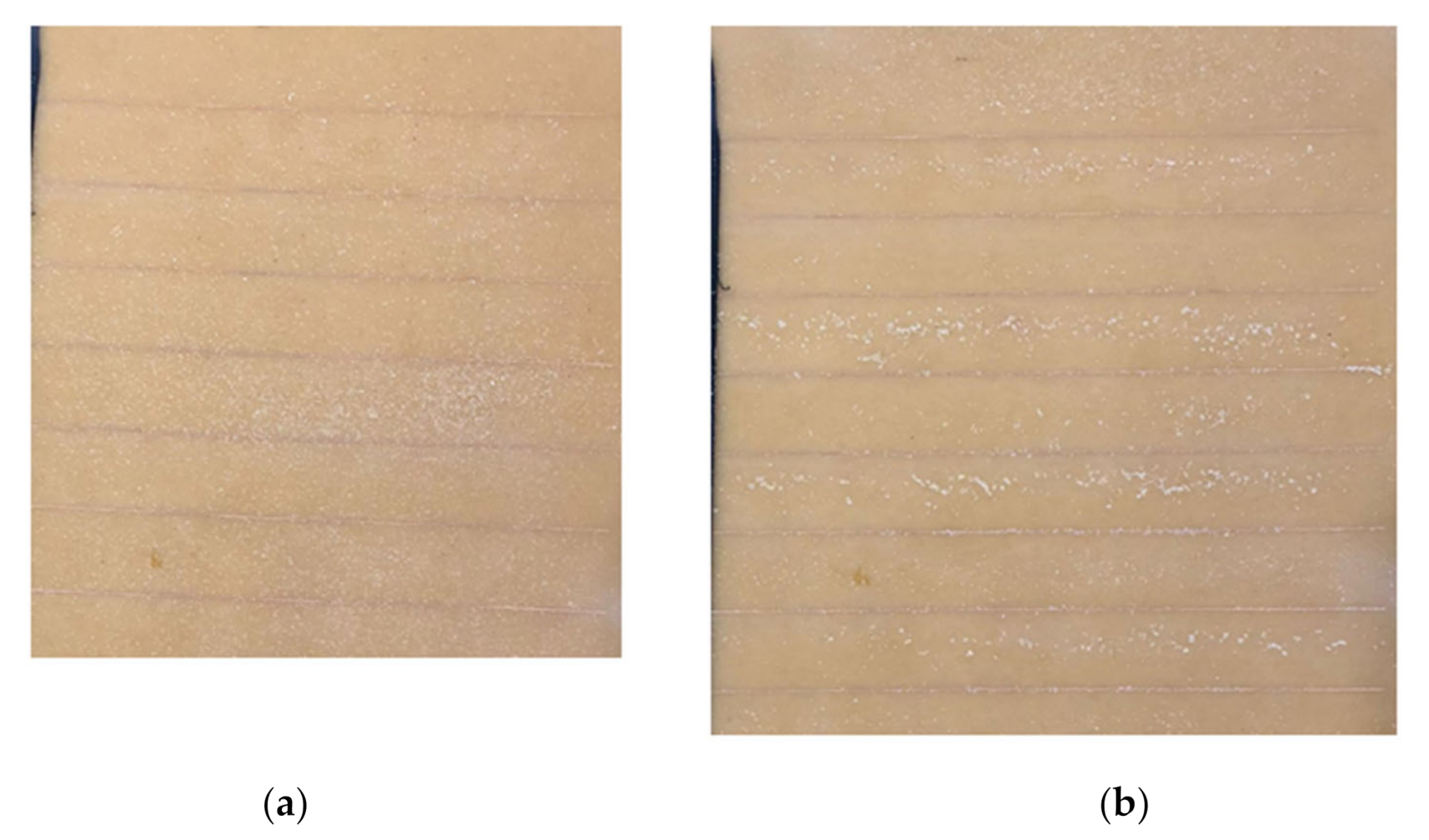

| Analysis Data | M1 Model | M2 Model | M3 Model | M4 Model |
|---|---|---|---|---|
| Total number of model elements | 848,914 | 2,514,898 | 1,257,488 | 876,010 |
| Energy error (%) | 0.653 | 0.407 | 0.401 | 0.694 |
| Analysis time (min) | 14:09 | 56:57 | 25:54 | 13:07 |
| Product Used | Amount | Unit | Unit Price | Total Amount |
|---|---|---|---|---|
| Cleaning Tractor | 1 | €20,000.00 | €20,000.00 | |
| Tractor Diesel | 100 | L | €0.80 | €800.00 |
| Cleaning Lady | 2 | €350.00 | €700.00 | |
| Cleaning solution or pure water | 395 | L | €15.00 | €5925.00 |
Publisher’s Note: MDPI stays neutral with regard to jurisdictional claims in published maps and institutional affiliations. |
© 2021 by the authors. Licensee MDPI, Basel, Switzerland. This article is an open access article distributed under the terms and conditions of the Creative Commons Attribution (CC BY) license (https://creativecommons.org/licenses/by/4.0/).
Share and Cite
Altıntaş, M.; Arslan, S. Reduction of Dust on Solar Panels through Unipolar Electrostatic Traveling Wave. Appl. Sci. 2021, 11, 9121. https://doi.org/10.3390/app11199121
Altıntaş M, Arslan S. Reduction of Dust on Solar Panels through Unipolar Electrostatic Traveling Wave. Applied Sciences. 2021; 11(19):9121. https://doi.org/10.3390/app11199121
Chicago/Turabian StyleAltıntaş, Murat, and Serdal Arslan. 2021. "Reduction of Dust on Solar Panels through Unipolar Electrostatic Traveling Wave" Applied Sciences 11, no. 19: 9121. https://doi.org/10.3390/app11199121
APA StyleAltıntaş, M., & Arslan, S. (2021). Reduction of Dust on Solar Panels through Unipolar Electrostatic Traveling Wave. Applied Sciences, 11(19), 9121. https://doi.org/10.3390/app11199121






